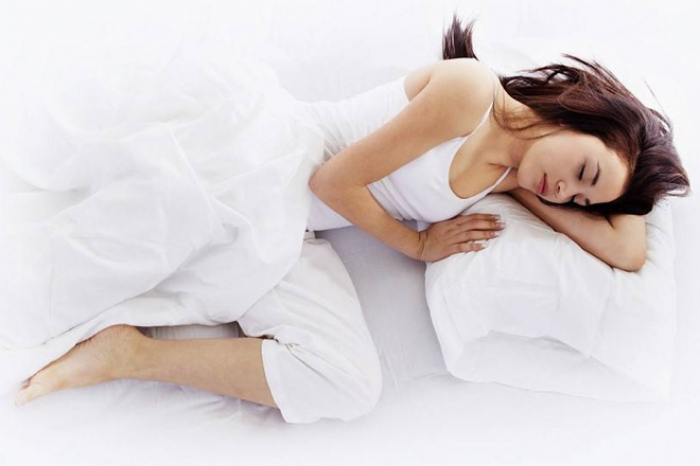But did you know that your choice of sleeping position could affect everything from how well your liver functions, to how likely you are to have nightmares and even how old you look?
However soundly we seem to sleep, we all subtly switch position at least a couple of times an hour as we move through the various sleep stages, according to experts. In fact, during deep non-REM sleep, our brain becomes “aroused” every six to eight minutes, says sleep specialist Dr Chris Seton.
These episodes are almost invariably associated with some kind of movement, whether rolling over or simply kicking out a leg. However, we tend to spend most of the night sleeping in the position in which we fall asleep.
Find out how your sleeping position could be affecting your health and well-being, and why a few tweaks could make all the difference…
ON YOUR SIDE...

The benefits
Almost two-thirds of us sleep on our sides. Lucky then that, according to experts, it’s probably the best sleeping position for overall health.
Side sleepers are less likely to suffer from snoring and sleep apnea than back sleepers, and have a reduced risk of back and neck pain compared with front sleepers.
Preliminary evidence even suggests that sleeping on your side could reduce your risk of developing neurological diseases like Alzheimer’s and Parkinson’s – the brain’s waste clearance system appears to function more efficiently when rats sleep on their sides.
The risks
According to Skin Repair expert Lorena Öberg, in an interview with MailOnline, sleeping on your side makes you more prone to premature ageing as it causes more folds in the skin than any other position. Experts also warn that side sleeping can encourage breast sagging.
Believe it or not, the side you tend to favour could make a real difference… If you want to ease the symptoms of heartburn and acid reflux, improve blood flow and get a more restful night’s sleep, the best side to sleep on is the left, say experts.
Sleeping on your right constricts blood vessels and inhibits circulation, which can result in more frequent movements during the night. However, sleeping on your left side can place additional strain on the liver, lungs and stomach, and is even associated with more frequent nightmares!
What does it mean?
Curious about your sleeping position’s meaning? Side sleepers who favour the foetal position (the most popular sleeping position, adopted by 41% of us each night) are said to be tough on the outside but soft on the inside.
Those who sleep with their arms stretched out in front of them as if reaching out or being chased are sometimes referred to as “yearners”. Yearners are thought to be optimistic dream chasers.
However, some suggest that they may be cynical and suspicious. Meanwhile, a side sleeper who sleeps “like a log” is said to be sociable and easy going.
Make it work for you…
Experts recommend sleeping on a pillow thick enough to fill the space between your shoulder, head and neck. Place a thinner pillow under the small of your waist and a third between your knees to minimise the risk of back pain.
To combat ageing, Lorena suggests a double cleanse at night to remove impurities, making sure the room is not too hot and using a hydrating serum or cream to boost moisture.
She advises against night creams that are too heavy – as they can block pores. Lorena also recommends using breathable bed linen like silk over synthetic bedding. “Silk causes less friction on the skin, preventing folds in your face, which leads to wrinkles”.
ON YOUR BACK...

The benefits
Concerned about wrinkles or sagging breasts? This is the best position to sleep in. It’s also the best way to sleep to minimise the risk of acid reflux, since gravity prevents food and acid rising up the oesophagus.
Suffer from back or neck pain? Sleeping on your back will help keep your weight evenly distributed and allow your head, neck and spine to maintain a more neutral position than sleeping on your front or side.
The risks
Sleeping on your back tends to worsen snoring and increase your risk of sleep apnea.
What does it mean?
“Log” sleepers who sleep with their legs together and arms by their sides are said to be rigid and inflexible, whilst “starfish” sleepers are thought to be generous, good listeners and excellent friends.
Make it work for you…
Ensure the natural curves in your spine are maintained by sleeping on a thin pillow and slipping a second one under your knees.
ON YOUR FRONT

The benefits
Stomach sleepers tend to snore less than back sleepers.
The risks
Sleeping on your stomach is not recommended by experts. Stomach sleeping provides no support for the natural curve of the spine and puts pressure on the joints and muscles, putting you at increased risk of neck and back pain. It’s also said to encourage wrinkles and breast sagging.
What does it mean?
Stomach sleepers are sometimes referred to as “freefallers”. Sleep psychologists believe they may feel they lack control in their waking lives.
Make it work for you…
Want to break the habit? Chiropractor Cynthia Vaughn suggests you take a tip from The Princess and the Pea – yes, really. She advises stomach sleepers to tape an uncooked pea to their stomachs before going to bed to dissuade them from rolling onto their stomachs during the night.
Can’t kick it, or just don’t want to? Try sleeping with your forehead propped on a soft, thin pillow to minimise neck pain – avoid twisting your head to one side. Place a second pillow under the pelvic area to support the natural curve of the spine.
More about: sleeping-position aging
















































